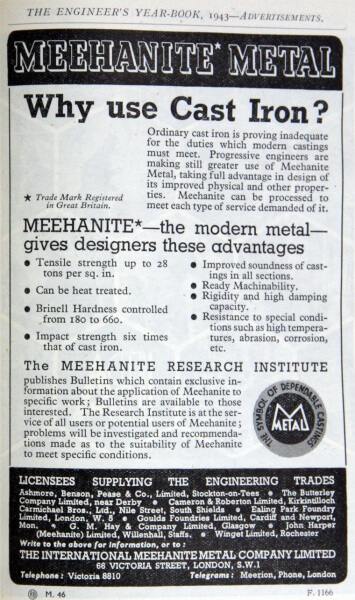Meehanite is the copyrighted trade name for a uniform, closely controlled iron cast to rigid physical properties. The Mine and Smelter Supply Company pioneered the use of Meehanite as applied to grinding mill construction.

Because of the uniformity of properties and assurance of manufacture according to engineering specifications, Meehanite metal has been selected for use in the construction of ball Mill heads, spur gears, bearings and other castings. Service performance during the past years has thoroughly justified and demonstrated the soundness of judgment in selecting this material.
COMPARISON OF PROPERTIES
A structural comparison of medium carbon cast steel, ordinary cast iron, and engineering types of Meehanite metal shows considerable similarity between ordinary cast iron and cast steel. They exhibit a matrix consisting of soft, free ferrite with areas of pearlite. In addition the cast irons contain a considerable quantity of coarse flake graphite. When making a direct comparison between a carbon spring steel and an engineering type Meehanite it is found that both materials exhibit a high strength, excellent wear resisting, fully pearlitic structure. The Meehanite metal, however, contains in addition a limited controlled amount of short well distributed flake graphite which is of great importance since it imparts free machining qualities as well as casting soundness, high dampening capacity for resonant vibrations, and freedom from notch sensitivity, particularly under dynamic fatigue stresses.
All metals tend to exhibit columnar crystallizations on changing from the liquid to the solid state and the junction of columnar crystals is a common cause of structural weakness in steel and other alloys. In the manufacture of Meehanite the nucleation of crystal growth assures the formation of an equiaxed crystal structure, free from planes of internal weakness, shrinks, cracks and columnar crystal embrittlement.
SOLIDITY, UNIFORMITY AND DEPENDABILITY
In the manufacture of any metal casting, uniform solidity and closeness of grain throughout all sections are basic essentials for dependable castings and the elimination or even reduction of shrink is a major problem with most metals. During the process of solidification steel will shrink some 12%. A soft gray iron casting will expand due to the separation of large amounts of soft flake graphite, and then contracts during the liquid-solid metal transformation. This results in expansion voids and internal porosity. With the mechanism of solidification of Meehanite castings the amount of graphite separating approximately compensates for this liquid-solid shrinkage. The significance of these facts is apparent since the Meehanite casting alone provides density and solidity when two or more sections come together.
A design and materials engineer is concerned with the many property characteristics of metals as an index of their behavior under service conditions. Thus the well recognized stress-strain diagram is often considered. Such a diagram will show that both steel and Meehanite type GA will have true modulus values where stress is proportional to strain. There is, however, no true index of modulus for ordinary cast iron. Steel has a clearly defined yield strength of a little over 35,000 PSI where very considerable plastic deformation occurs without further load increments. Beyond this yield strength steel would have little service value. On the other hand a Meehanite metal casting could withstand momentarily, overloads beyond this value without serious deformation even though the ultimate strength was markedly lower than that of the steel casting.
SERVICE PERFORMANCE
Several properties which are of particular significance to the engineer have been listed. Low notch sensitivity of Meehanite metal in relation to the effects of keyways, grooves, sharp fillets or defective machine finish as stress raisers, in comparison with high notch sensitivity of steel is of major importance with parts subjected to dynamic stresses. The significance of this property is clearly defined by data obtained on the marked reduction in fatigue strength of steel when subjected to notch effects.
The reduction of endurance limit of Mehanite type GA by induction of a groove or notch amounts to only about 20% as compared with 50% reduction for steel under the same conditions.
Since the fully pearlitic structure of Meehanite is comparable to that obtained in spring and carbon tool steels, this engineering iron provides excellent resistance to abrasion and erosion with the added advantage of high dampening capacity which is effective in units subjected to dynamic loading. Cast steels contain considerable quantities of soft free ferrite which has low strength and low hardness with poor abrasion resisting qualities, and also poor machine characteristics.
As a gear material Meehanite metal is excellent. The high dampening capacity for vibration of Meehanite irons prevents building up of resonant stresses and assures noiseless, smoother operation. The maintaining of high strength properties with low coefficient of friction and excellent resistance to wear assures long life in service while its capacity to resist surface breakdown renders it as an ideal gear material.
The above statements briefly discuss the main qualities of Meehanite which are especially important when considering a material to be used in the manufacture of grinding mills. In both ball mill and rod mill operations the heads are stressed alternately in compression and tension. This condition is produced by rotation and aggravated by vibration caused by the grinding media. Meehanite, due to its controlled structure and uniformly disseminated carbon content has dampening qualities which minimize the effect of vibration.
